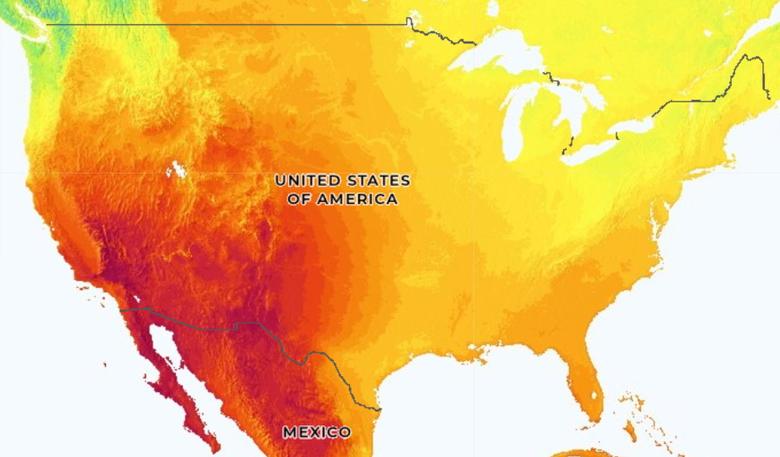Fossil fuels cause three quarters of global warming. However, solar and wind are rapidly taking over electricity production: they comprise three quarters of new global generation capacity because they are cheap and getting cheaper. Clean electricity can replace coal and gas electricity generation, energize electric vehicles, heat homes, and power most of industry. Complete removal of fossil fuels from the US economy requires a tripling of electricity production, and investment of about $5 trillion by 2050 in solar and wind.
Texas is the second largest state by both area and population and has major expertise in the energy industry. Texas is in the south of the US, which allows it to generate plenty of solar electricity even in winter. Unlike most states, Texas has both good solar AND good wind. All of this means that Texas has great prospects for becoming the renewable energy powerhouse of the US.
Texas can ship vast amounts of solar and wind electricity to the northeast states and to the west coast. State of the art high voltage power lines can transmit 12 Gigawatts of power over 2,000 miles with loss of only 10%. Texas could readily garner a trillion dollars of investment in its renewable energy industry by 2050. But there are three things that Texas needs to do.
- adopt friendly policies to encourage solar and wind farms within the state.
- strongly interconnect with other states to allow electricity export. Failure to do this would be like Texas deciding not to export oil to other states.
- invest in large-scale energy storage. This allows solar and wind electricity exports to meet the varying demand for electricity. For example, storage lets Texas export solar electricity in the middle of the night.
Fortunately, there is a vast, low-cost, off-the-shelf, environmentally benign storage solution that already has 99% of the global electricity storage market, namely pumped hydro. There is a twist: nearly all the best pumped hydro sites are not on rivers - they are off-river sites.
An off-river pumped hydro system comprises a pair of reservoirs located away from any river and spaced several miles apart with an altitude difference of 1,000 to 4,000 feet and connected with pipes or tunnels. The reservoirs can be purpose-built or can utilise old mining sites or existing reservoirs. On sunny and windy days, water is pumped uphill to the upper reservoir. At night-time, the water flows downhill through the turbines to generate electricity.
Off-river pumped hydro requires very little land. For example, a pair of reservoirs with a combined area of a square mile, average depth of 60 feet, and an altitude difference of 2,000 feet, can store 30 Gigawatt-hours of energy, which means that the system could operate at a power of 1 Gigawatt for 30 hours. This is enough storage for a city of a million people. Very little water is needed compared with a coal power station because after filling, the water cycles between upper and lower reservoirs for a century.
Batteries and pumped hydro storage are a great combination. Batteries are preferred for small-scale energy storage, while pumped hydro is much cheaper for overnight storage to manage the day-night solar cycle.
The global pumped hydro storage atlas shows 35,000 good sites in the US. The Atlas lets you zoom and pan to view the 3-D shape of reservoirs and includes information pop-ups. Only a few hundred sites will be needed to support a 100% renewable US electricity system, which allows utilities to pick and choose the best sites. Texas and neighbouring states have plenty of off-river pumped hydro energy storage potential, much more than enough to support a major electricity export industry in Texas.
Where might Texas go with renewable energy in the 2020s? Look down under to Australia, which is installing solar and wind 3 times faster per capita than the US. Australia has 36% renewable electricity and is tracking towards 50% in 2025 and 90% in 2030. The state of South Australia has already reached 75% solar and wind and regularly operates for days on 100% solar and wind. Australia has three existing pumped hydro systems, two new systems under construction with larger energy storage than all the utility batteries in the world put together (Snowy 2.0 and Kidston), and another dozen under development. None involve new dams on rivers.
The US is accelerating deployment of solar and wind to reduce emissions at low cost. Fortunately, it has vast potential for technically mature, low-cost, off-river, low-environmental-impact, pumped hydro storage. Texas can have a central role in the energy transition if it wants to.
US solar energy potential (redder is better)
US pumped hydro sites
-----
This thought leadership article was originally shared with Energy Central's Clean Power Community Group. The communities are a place where professionals in the power industry can share, learn and connect in a collaborative environment. Join the Clean Power Community today and learn from others who work in the industry.
-----


















